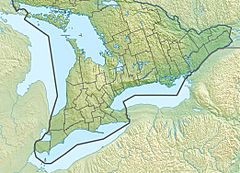Tay River facts for kids
Quick facts for kids Tay River |
|
|---|---|

Tay River in Perth
|
|
|
Location of the mouth of the Tay River in southern Ontario
|
|
| Country | Canada |
| Province | Ontario |
| Region | Eastern Ontario |
| County | Lanark |
| Physical characteristics | |
| Main source | Bobs Lake Lanark Highlands 162 m (531 ft) 44°45′34″N 76°31′21″W / 44.75944°N 76.52250°W |
| River mouth | Lower Rideau Lake, Rideau River Port Elmsley 125 m (410 ft) 44°52′43″N 76°06′46″W / 44.87861°N 76.11278°W |
| Length | 95 km (59 mi) |
| Basin features | |
| Progression | Rideau River→ Ottawa River→ Saint Lawrence River→ Gulf of Saint Lawrence |
| River system | Ottawa River basin |
| Basin size | 850 km2 (330 sq mi) |
The Tay River is a river in Lanark County in Eastern Ontario, Canada. It is in the Saint Lawrence River drainage basin and is a left tributary of the Rideau River.
The Tay River watershed, covering a drainage area in excess of 800 square kilometers, is the westmost of the 6 recognized subwatersheds managed by the Rideau Valley Conservation Authority.
Contents
Course
This river starts at Bobs Lake and leaves the lake, controlled by a weir, near the community of Bolingbroke in geographic South Sherbrooke Township, part of the municipality of Tay Valley. It heads northeast, passes under Lanark County Road 36, reaches Christie Lake and passes there into geographic Bathurst Township. It continues northeast, passes under Lanark County Road 6, and divides into two channels; the right channel is known as Scotts Snye. The river then travels through the community of Glen Tay, continuing to Perth. The river splits into two main channels as it flows through downtown Perth. The two channels have recombined by the time it leaves Perth and continues to the Rideau River, which drains via the Ottawa River into the Saint Lawrence River.
The river is 95 kilometres (59 miles) in length and drains an area of 850 square kilometres (330 square miles). A canal connects the river to the Tay Canal, and Rideau Canal systems at Beveridge Bay on Lower Rideau Lake.
Lakes in the Tay watershed
Top of Watershed (above north-south railroad line from Oconto to Tichborne)
Abbott, Barton, Carnahan, Clow, Danby, Duncan, Eagle, Elbow, Leggat, Little Beaver, Little Mud, Long, Miller, Oconto, Scanlin, Spruce, Watson
Middle watershed (between Oconto/Tichborne line and Christie Lake)
Atwood, Beaver, Bobs & Crow, Buck Bay, Burns Pond, Christie, Crosby, Davern, Deer, Doran, Farrell, Green Bay, Lake of the Hills, Little Crosby, Little Rock, Little Silver, Little Twins, Lynn, Mud Bay, O’Brien, Pike, Rainbow, Rock (north), Sucker, Thompson Pond, Victoria, Weatherhead
Below Christie Lake
Andrew, Doctor McLaren, Mills, Mud, Otty, Rock (south), Thoms Mud
History
The Tay River was formed during the retreat of the Champlain Sea after the last ice age. The name given to it by the Mississauga First Nation, who controlled its territory at the time of the arrival of the first European settlers, appears to have not been recorded. They used its territory for hunting, especially in the winter, and likely harvested manoomin (wild rice) on some of its lakes, for instance Christie Lake. Early European settlers called it the Pike River; the name Tay replaced it at some time during the arrival of many Scottish settlers after the founding of the Perth Military Settlement in 1816, doubtless in reference to the River Tay in Scotland. The new name was already clearly established during the construction of numerous mills on the river in the 1820s, and the Tay Canal in the 1830s.
Mills on the Tay, the Tay Canal, and more broadly the resultant access to the Rideau Canal system provided important commercial connections from Frontenac and Lanark Counties to Ottawa and markets beyond, in particular for logging. Dams on the upper Tay created lakes (e.g. Bobs Lake) that were reservoirs of water for the Rideau Canal at the time, and are important to cottagers and seasonal residents today.
Following municipal amalgamation in Ontario in 1998, the river has provided its name to the municipality of Tay Valley, Ontario, even though the municipality neither wholly contains, nor is wholly contained by, the Tay River watershed.


